From Rocksmith to Free Guitar Effects and Home Studio Recording
by admin on Dec.04, 2011, under Linux, Music, My Life
[poll id=”3″]
If you have Rocksmith for PS3 or X-Box, a Realtone guitar cable, and have a PC or Intel-based Mac, you have everything you need to extend your playing from the game into a home studio and guitar effects processing and jamming session, not just for yourself but for friends as well. Want to add vocals? No problem, just plug in that Rockband or Guitar Hero USB microphone and you can record audio too. You have everything to extend your playing from Rocksmith into endless possibilities using your home computer – and it is utterly free. (Compare that to what you have to spend for something like ProTools.)
All you need to do is download a bootable Linux CD, such as AVLinux, boot your computer with it, plug in your guitar using the realtone cable, and run the software on the CD and you can unleash a vast array of guitar audio effects (pedals), as well as easily record yourself (with multiple tracks), add vocal tracks, etc. If you have a MIDI capable drum kit or keyboard (especially with an M-Audio MIDI adapter), you can very likely use them as well.
And the best part: it’s free. There is zero cost for the software as it is based on an Open Source operating system (Linux), and Open Source applications such as Rakarrack, Guitarix, Ardour, Soundgarden and others. AVLinux also comes with commercial software, and previews of other available tools, but everything on the CD is free to use.
Here is how it works:
The realtone guitar interface cable Rocksmith uses is really just a simple USB sound card which is seen as a USB microphone by a computer or console game system. This is actually identical to other 1/4″ to USB adapters such as the Behringer UCG102 Guitar to USB interface. Linux has excellent support for USB audio devices, and the Rocksmith realtone cable uses a chipset which is support by the snd-usb-audio Linux drivers (and for Mac by OS X 10.6). Support is built in to Linux, so you can simply connect the realtone cable to a Linux system and jam away. (However, you can not connect something like the Behringer UCG102 to your PS3 or XBox to use with Rocksmith. Although they perform the same function, the game will only work with the realtone cable. Yep, lame.)
The real magic is not the cable, but Linux. If you have never used Linux, don’t be afraid. If you can download and burn a CD you can get started using Linux. You will actually find Linux itself easy enough to navigate around in, but learning to control the vast number of audio application which are now at your fingertips may take a bit longer. (You can also very likely use Garage Band for OSX, but the wealth of audio tools on AVLinux is an order of magnitude beyond this and is more comparable to ProTools and more.)
The below steps are written assuming you know nothing whatsoever about Linux. If you get stuck you will find there are many online forums where help is available. NOTE: Please see the AVLinux user manual, found on the desktop – it is an excellent guide and will quickly get you started. Also, get help from a computer geek friend – especially if they know anything about Linux. (Make sure to provide the beer.) It might seem daunting at first, given the extent of software available, some of which is very full featured, and complex. However, you should be able to at least get up and running so you can hear your guitar and uses pedal like effects pretty easily. From there you can dive into the more complex tools, like Ardour for recording, etc.
Here is how to do it:
While there are many flavors of Linux other there, and several ways you can do this, I highly recommend downloading the LiveCD version of AVLinux from here.
(For more information on other Linux versions available, see the geek notes at the end on “Other Linux Environments”. Just use AVLinux for now though unless you have reason not to.)
Make sure you download the “live” version, and burn the .iso as an image, and don’t copy the .iso file itself to the blank CD. Then, restart your computer with this CD in it. It should start up and take you to the Linux Desktop. (NOTE: If it does not, you may need to configure you computer to boot to CD first. If you are using a Mac, hold down the alt or ‘c’ key while powering on the system and until after you hear the chime.)
Be patient, it may take several minutes for the desktop to appear.
Now, simply plug in the Realtone audio cable. Next, you must configure the system to use the Realtone cable as the proper input, and the computer as the output. This is done using the Jack audio server, which can be controlled by running qjackctl. There is a little green icon on the system tray at the bottom of the screen which will start qjackctrl.
Configuring Jack is likely going to be one of the hardest parts to set up the first few times. The idea is you are patching together software audio tools, as though you were connecting them to each other using physical audio cables. You can then string together different tools. The first thing you need is to ensure the Realtone input is connected to the system output. The basic JACK configuration should look something like this:
TOP TIP: Click on the > button in Jack next to the input device to see more descriptive names for the inputs and outputs. If you just try to use the drop down menu (hw0, etc.) it is easy to get them wrong. The Realtone cable will be list as a “Rocksmith USB Guitar Adapter” or “Hercules” or “Sony Entertainment”.
Now you can start other audio software and connect those applications to Jack as well. For example, we will now start Guitarix (a guitar effects processing tool) so we can jam with all those nifty effects, and make our own. Start Guitarix from the audio applications menu (Hint: Not all entries are alphabetical, it’s actually at the bottom of the list). The interface, with a couple mono plugins and tuner enabled might look something like this:
TIP: the red and green power lights on the left must each be powered on by clicking it for it to be active in your effects loop.
qjackctl should automatically now see Guitarix as another available application to “plug” into, and the connections should look something like this:
TOP TIP: Many users find the default patch bay display in JACK very confusing. You can also try out Patchage, in the audio application menu, which I find displays the patch connections in a much more intuitive and manageable way. Also see this helpful diagram of how to connect guitarix to JACK at the Guitarix site.
You can now jam away, and explore a huge number of guitar effects. Add more effects from the Options -> Mono Plugins menu. Chain them together to get the exact sound you like.
NO SOUND: Most likely you need to re-examine your JACK configuration. Also it helps to activate the tuner in guitarix (Options -> Tuner), to verify the signal is getting to guitarix. If so, you are very, very close. Check your JACK configuration setting, both in the patch bay and the inputs and outputs under the “settings” tab. Its easy to get something wrong here. Also, make sure to turn up the pre-gain, drive and master gain knobs as needed. (This applies to other applications too: Effects often have power switches that must be clicked on to activate them, and volume levels may need adjusted – things may be working perfectly, but you just need to bump up the gain.)
Whats Next?
This is just the beginning. Using the same steps you can now also use other applications. Want more guitar fx? Try Rakarrack – the possible sounds you can create with it are endless. It has pre-configured banks of effects, and you can make your own custom sound. (Again, enure you active the fx power switch (top left) and adjust the volume sliders.)
Here is a screenshot of Rakarrack configured for JACK. This is an amazingly fun guitar fx tool with a stunning array of sounds:
Want to record yourself? Try Ardour – also already installed and available in AVLinux. Plug in a USB microphone (Rockband and Guitar Hero ones work fine), configure it in Jack and you can record vocals in Ardour too. (Ardour has extensive features, and you will want to head over to the website to check out the tutorials.) For keyboards check out Rosegarden and for Drums try Hydrogen.
Record yourself with Ardour:
Next Steps
Running from the LiveCD is a great way to get started, but you most likely will eventually want to install AVLinux either to a USB stick, or to your computer. This will allow you to save changes, and improve performance. The AV Linux control panel on the system tray even includes an option to make a bootable USB stick, as well as many other very useful tools. This attention to providing a very user friendly environment, and the excellent user guide on the desktop are additional reasons why I recommend AVLinux.
Summary
Take your playing and skills to the next level using powerful and freely available open source tools. Linux is a fantastic platform for musicians, and the number and quality of tools available is impressive. If you run into trouble, you will likely find places like Linux forums, and forums for tools like AVLinux, Rakarrack, and Guitarix, to be quite helpful. It can get complicated, its true. But if you stick with it you will be well rewarded.
Advanced and Troubleshooting Advice
(Warning Nerd Stuff Coming – you can skip it unless you want more info)
First off – check out the user manual on the desktop (or from the AVLinux site). It has tons of good info, useful terminal commands, etc. Here are some basic tips for common issues:
No Audio
Start a command shell and run:
$speaker-test
$aplay -vv /usr/share/sounds/alsa/Front_Left.wav
If you don’t hear anything, restart the sound server:
$sudo /etc/init.d/alsa-utils restart
Then re-try the speaker test. This must work before JACK or any other applications will.
If it still does not work, make sure your sound card was detected (cat /proc/asound/cards )
Troubleshooting the realtone cable
Prior to plugging in the cable, open a command terminal and run:
$sudo udevadm monitor
Plug in the Realtone cable and see if udev correctly detects it and assign it as an audio device.
Also, ensure it is visible when you run
$sudo lsusb -v
Using VirtualBox
Running for a LiveCD forever is not the way to go. Instead, you can install AVLinux as a virtual machine using VirtualBox. You will also need to VirtualBox USB extensions. Note there is going to be increased latency this way for sure, in fact so far the latency has made it pretty unusable in my tests. You may well need to increase the “Frames/Period” in JACK settings to 1024 or even 2048. I did have trouble with the VM crashing in VirtualBox (4.1.6) running on my OpenSuse 11.4 system with VERR_NO_MEMORY errors, despite having plenty of memory allocated to it. It does seem to work okay when I briefly tested it with VirtualBox on a MacBook Pro, OS X 10.6.8 Audio was working okay – though getting the Realaudio cable recognized by the VM was a bit tricky, even when adding a USB filer for it. All in all, my experience shows that due to latency and timing demands, and overhead of the hypervisor may make this unrealistic except under ideal hardware and conditions. A better option would be running from a USB stick, which should run considerably faster than the LiveCD, or better yet of course actually installing Linux.
Other Linux Environments
You can install any mainstream Linux distribution (OpenSuse, Ubuntu, Fedora, etc.) on your computer, and then install the needed audio applications for the repositories, or build them from source. However, I recommend using the AVLinux LiveCD to start users off without needing to install anything so they can just jam, have fun, and test drive things.
OpenSuse MultiMedia Studio
(LiveCD and Installable)
Based on Suse 11.4, this is both a LiveCD and installable Linux environment. It can also be customized using the OpenSuse Build Service, and built a an .iso, usb, or VirtualBox image, which is very cool. You can add guitarix and rakarrack to the build. I do want to test drive this fully, though it lacks the extensive collection of pre-installed audio specific applications that AVLinux offers.
Studio64
(Only 2.0 version available as Live CD, newer versions are install only.)
Other LiveCD options include the 64Studio 2.0, but that is based on Debian 4.0, which is very old at this point. While 64Studio is available in newer versions, they are not available in as a LiveCD. If you wish to install a full Linux OS, I would certainly recommend looking in to it.
Ubuntu Studio
(Latest is Ubuntu 11.10 base. No LiveCD option)
Developed for a mix of audio, video and graphics arts. Looks pretty good, but not music focused – and there is no LiveCD available.
Leave a Reply
You must be logged in to post a comment.
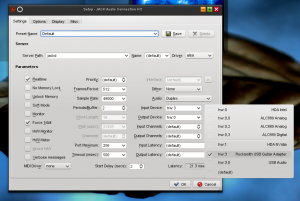
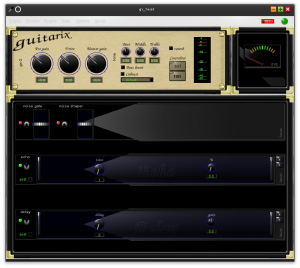
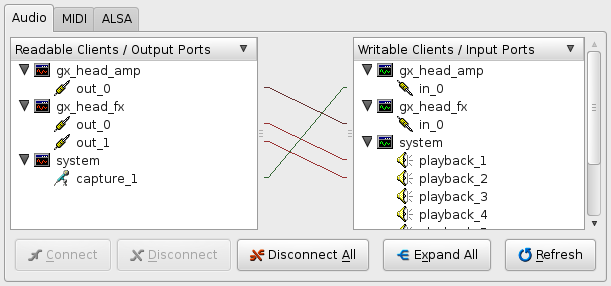
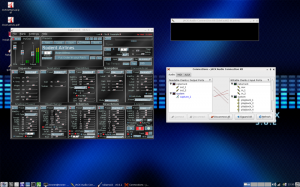
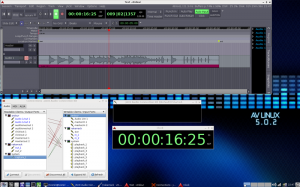
December 5th, 2011 on 9:04 am
Wow! Thanks for sharing this info. Props to Ubisoft for using a generic usb sound thing and not using a proprietary dongle. The array of professional open source sound software sure is impressive.
January 14th, 2012 on 8:05 am
Have you actually tried connecting the Behringer USB Link to the PS3? My Rocksmith cable is broken and I’m wondering if I should get one of those…
January 14th, 2012 on 10:46 am
Hi There,
Unfortunately, the Behringer cable is not recognized on the PS3, so you will need to get a new Rocksmith cable, Amazon has them for $30.
Cheers,
January 25th, 2012 on 11:04 pm
Hi,
Great Article 🙂
I’m the developer of AV Linux. Thanks for using it as part of your guide. I’d invite any new users to check out the forum if you require assistance or are looking for more info.
http://geekconnection.org/remastersys/forums/index.php
January 26th, 2012 on 9:12 am
Hi there,
Thanks for stopping by and for the forum link!
I’ll should be doing another post pretty soon on enabling pulse audio in AVLinux for running GuitarPro, which I think might be helpful for some users.
Thanks for the work on AVLinux – it is fantastic.
Cheers,
January 27th, 2012 on 11:40 pm
Cool!
I’ll look forward to it. BTW an updated AV Linux 5.0.3 ISO will be released in a couple of weeks with a full introductory screencast accompanying. No huge changes but a lot of program updates, a newer kernel and much improved versions of Kdenlive and Cinelerra and a few other small surprises…
Keep up the great info on the blog here…Good Stuff!
March 20th, 2012 on 9:10 pm
Gary, You rock with AV Linux I just brought it up. Whoever wrote this page is bitchin because my next move is to plug gs cable in and config, so now I know where to go. I did load guitarix source because I want to change it for my AMP. It’s not in AV now right?
April 16th, 2012 on 2:11 am
I am new to Ubuntu. I made the change from xp to Ubuntu 11.10 in Feb 2012. installed all the software besides linux av. Do I need it? I have configured the as pictured above but I have no sound from my guitar through the cable into the usb port. Everything else is working fine. How do i install linux av using a usb port? I love Ubuntu. Linux is happiness. Thank you.
April 17th, 2012 on 12:49 pm
Hi there,
Congrats on the switch to Ubuntu. To clarify your options:
1) You can install AVLinux as a separate Linux OS, parallel to your existing Ubuntu. You would then boot into either Ubuntu or AVLinux as needed. It is not uncommon at all to run more than one version of Linux on your computer, and simply boot into the one you wish to use. You will need to resize the existing partition(s) to create room for the AVLinux – back up anything important first (onto a USB stick, etc.) as resizing partitions is a bit touchy. (There are many web guides on resizing partitions and dual booting multiple versions of Linux.)
2) You can not use AVLinux at all and instead install most of the same applications in your Ubuntu install. For example, you can simply do a sudo-apt get install rakarrak or sudo apt-get install ardour to install those programs. This should allow you to start using them immediately. (You will also need qjackctl to set up Jack.)
The advantage of use AVLinux as its own stand alone OS is that it has a great many audio and recording applications not only pre-installed, but also the environment itself has been tuned for optimum performance. Everything “just works” out of the box and works very well.
April 21st, 2012 on 9:20 am
Hello,
You said
“This is actually identical to other 1/4″ to USB adapters such as the Behringer UCG102 Guitar to USB interface”
Did you actually tried both ? If yes are they reaaly the same ? I’m considering to buy one of those but, if I would prefer to avoid the rocksmith cable, I’ve seen that the behringer has worse review on amazon.
May 26th, 2012 on 10:36 am
Yes – I tried both. They are different USB sound devices and the PS3 will not recognize the Behringer.
July 1st, 2012 on 3:29 pm
Thanks. It’s not for using with a console but for recording on PC. I was thinking to buy the Behringer but the Rocksmith cable had better review , and I was not sure which to choose.
October 12th, 2012 on 2:27 pm
I just picked up a Rocksmith cable. I also have the Behringer UCG102.
I’m using Ubuntu Studio and I’m having problems with PulseAudio sending sound to the UCG102 headphone jack instead of my sound card while jackd is runnning. The Rocksmith cable doesn’t have a headphone jack, I’m hoping that will solve that problem.
I’m also hoping that the Rocksmtih cable will work at 48k. I could never get the UCG102 to work at 48k had to drop it to 44.1k. Not sure if it’s because machine specs (Core Duo 2 2.6GHz) or if the UCG102 is falsely advertised as 48k.
Have you tried the UCG102 at 48k and got the latency lower than 5 ms?
October 25th, 2012 on 1:23 pm
Can i get the game to work with the behringer on the pc? with linux?
November 17th, 2012 on 1:04 pm
Rocksmith is available for PC, and is also on Steam.
http://store.steampowered.com/app/205190/
(Hopefully, with Steam coming for Linux soon this might be one of the titles.)
November 17th, 2012 on 1:10 pm
Hi there,
Hope the Rocksmith cable worked well for you. I was able to get the UCG102 working at 48k, though I don’t recall what the latency was. I assume with Ubuntu Studio you had jack running with RT enabled? You might want to try, just to see, another distro like the AVLinux liveCD, which does not use pulse. Of course changing from Ubuntu studio not not be of interest to you, but trying it out in AV Linux might be interesting just to see. My setup has been OpenSuse, with pulse, and I’ve had pretty good success getting everything to work.